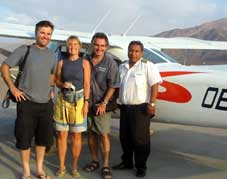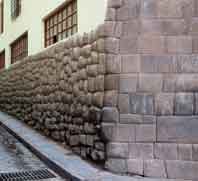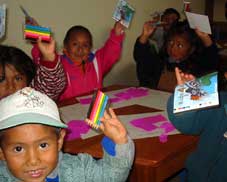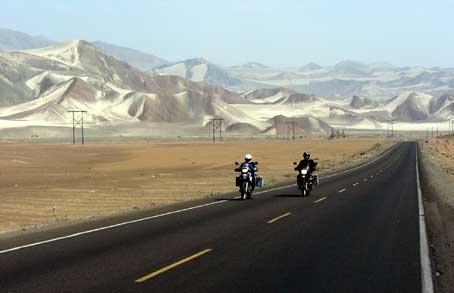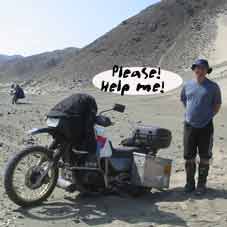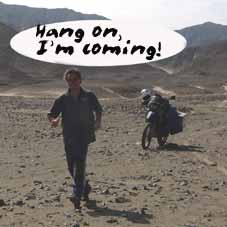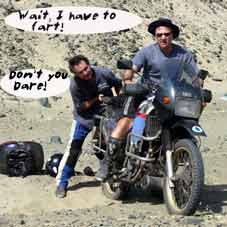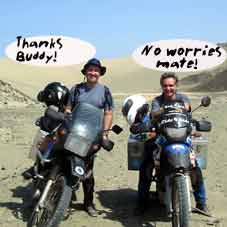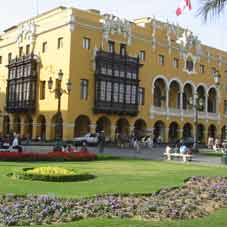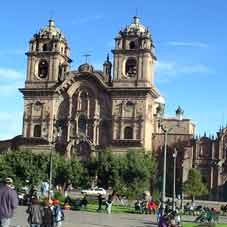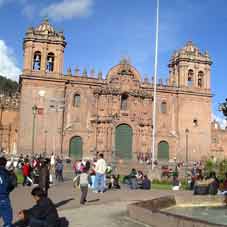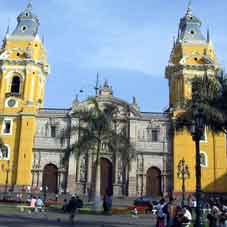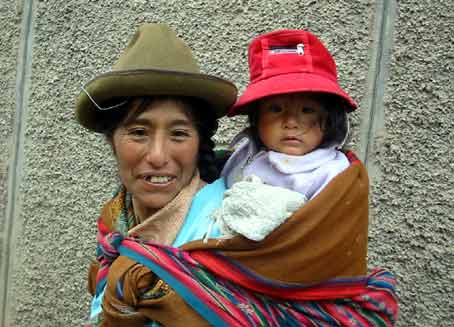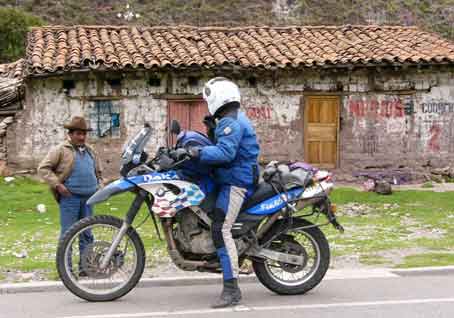Machu Picchu
and the Inca Empire.
Friday,
9 January 2004.
Crossing the border to Peru turned up to be a piece of cake. Again, I
used my expired carnet de passage (passport for my bike) to enter it
in Peru and nobody noticed anything. For some reason, I was not able to use
my carnet in Central America, but it seems to be a different story in South
America.
This
is my second visit to Peru; the first one was in 1990. Peru is the third largest
country in South America and has a population of around 27 million. It is home
to what is viewed by many as the finest archaeological site on the continent
- Machu Picchu. It is in Peru that the fabulous Inca Empire flourished
over 600 years ago and it is in Peru that pre-Columbian inhabitants of the coastal
desert near Nazca, drew fantastic geometric shapes on the desert floor
without any apparent or decipherable reason (more about that later on). Geographically,
Peru has three distinctive regions, the narrow coastal belt which is mainly
desert, the wide Andean mountains with
heights
up to 6768m and the Amazon rain forest. Its main exports include copper, fish
products, agricultural products, zinc, gold and petroleum products. However,
unreported revenue from coca (exported for cocaine production) is, according
to some sources, roughly comparable in value to all legal exports combined.
Today, tourism plays also an increasingly important role in the national economy.
By the way, the mystery about the source of the Amazon River is solved. It's
a stream beginning on Nevado Mismi, a mountain in southern Peru. A five-nation
team pinpointed the source with the aid of satellites. No doubt that this fact
will make your day easier.
By midday, we were across the border and driving along the Pan-American Highway
which was following the coast. Catherine was still with me and we were
chasing Madmax Simon. The weather was spot on and the scenery so different
from the last few weeks. On my left was the dry desert and on my right the Pacific
Ocean. The road was straight and in perfect condition. We reached Puira
by 4pm having covered 540km. Puira is Peru's oldest colonial city and has a
population of 300,000 inhabitants. Rivers running down the western slopes of
the Andes form about 40 oases, which are agricultural centres in the middle
of the desert. Puira is one of them. This is where we caught up with Madmax
Simon himself. I could see that he was glad to see us. After waiting for 3 weeks
in Panama for a visa, he had spent a very lonely Christmas and New Year in Colombia.
He was stuck a further 5 days at the Colombian/Ecuador border.
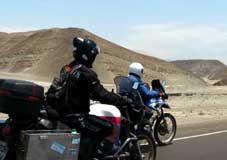
The
next day, the three of us left early toward Trujillo. Again, the weather and
the road were perfect. The desert reminded me of the Nullarbor in Western Australia
and it was a welcome relief to go through the oases from time to time. We arrived
in Trujillo in mid-afternoon having covered only 442km. The 2 hours lunch
break (very unusual for me) did not help anything. Trujillo is the third largest
city in Peru and the largest in the
northern
part. It is an attractive town that has retained much of its colonial flavour.
We spent a pleasant evening walking along the streets and watching the locals
enjoying their late Saturday night shopping. It was hard to believe that we
were in Peru. The modern shops and the well dressed customers had nothing in
common to what I expected Peru to be like.
With Lima (the capital) only under 600km away, we were on a mission to
reach it on the following day. It was a bit hard to get Simon out of bed but
we finally succeeded and we were on our way at around 9am. The ragged desert
made place to sand dunes which took me back to Sudan or Egypt. Simon, who was
a virgin as far as sand riding goes, insisted on having a closer look. With
the latest stage of the Paris Dakar still fresh on his mind, he set up across
the sand dunes as if he was leading the race. I followed slowly behind knowing
very well the tricks of the sand. Days of it in Northern Sudan had taught me
a few things. Five minutes later, I could see that Simon was not going as fast,
in fact he
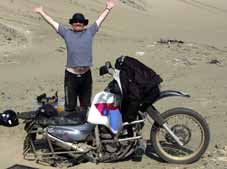
was
not going anywhere. He had buried his back wheel 50cm deep in the soft sand
(pictured). "How do I get it out?" said Simon. As I was pretty
sure that he meant his bike, I came to the rescue. We took his entire luggage
off the bike and lifted the rear of the bike out of the hole. Ten minutes later
we were safely back on the tarmac. As we got closer to Lima, we could detect
more and more police along the road. I was the first one
to
"cop" it. They stopped me just before a toll (free for motorcycles)
accusing me of riding over a double yellow line just metres from the gates.
Straight away they took my license away and started to fill out the fine very
slowly. The fine was supposed to be around US$50 and because it was a Sunday,
it meant that I would have to wait until Monday morning to pay the fine (just
like in Nicaragua) and recover my license. It was very obvious that all they
wanted was a bribe but I was determined not to pay it so I pretended not to
understand. With a bit of patience I would have probably succeeded but Catherine
and Simon were waiting for me and it was getting late. To cut a long story short
I finally gave up and paid my first ever bribe. I gave them US$6 and was told
later on that I got away pretty well as most people pay between $15 to $20.
We were still 150km away from Lima and we wanted to be there before dark. No
more than 40km later we got stopped by the police again. This time we were charged
for doing 64km/h in a 45 zone. Again we pretended that we did not understand
what they wanted. Catherine, who had not been stopped, came back to see if she
could help us (she is a lawyer). Right away she was charged for doing a U turn
in a no U turn zone. It was laughable to say the least. Simon did not dare pick
his nose by fear of another fine. Again they started to fill out the form very
slowly and kept on saying that what we did was very naughty. Obviously, they
were after a bribe as well. I don't know if it was our dumb and dumber act or
Catherine's "I will do anything" smile that did it but they eventually
let us go without paying anything. We promised them to be very good and we did
as they seemed to be every 5km with their radars all the way to Lima. We finally
arrived there at dusk.
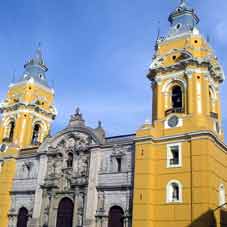
Lima's
colonial charm has been overwhelmed by an uncontrolled population explosion
that began in the 1920s. About one-third of the nation's 27 million inhabitants
now live in Lima, and most of the city is overcrowded, polluted, dangerous and
noisy. Much of the growth results from the influx of very poor people from other
areas of Peru who come in search of a better life. But jobs are scares, and
most end up living in the shantytowns surrounding the city centre. Those Shantytowns
lack electricity, water and adequate sanitation. Lima suffers also from the
coastal fog that blots out
the sun and blankets the buildings in a fine
grey mist. The smog also makes walking the streets unpleasant.
In 1990, I had flown straight from Los Angeles to Lima. That was my first
ever visit to South America and my Spanish was nil. I had heard some horror
story about Lima, mugging and robberies were a daily occurrence. So, on that
first day, I set out in the centre with only a photocopy of my passport and
just a couple of dollars to eat something. I had figured that if I had nothing
on me I would lose nothing. As it turned up I was very wrong. As I was walking
along, a man came to me and asked me something. I did not understand and told
him so. Next, a policeman came to join us and asked for our ID's. The man
did not have any and I gave him the photocopy of my passport. That was not
good enough and we were both taking in a police car to the police station
for further inquiries. You can understand that I was not feeling very brave,
after all I had only been in town for a few hours and I was already arrested.
Little did I know that it was going to get much worse. On the way to the station,
one of the policemen started to check the other man's arms. They showed some
traces of needles. They checked mine as well, then my nose but could not see
anything. My belt was taking out as well. I was carrying a day pack with a
guide book and some water in it. They took it from me and search it. To my
astonishment they produced a little white sachet from it. The cop showed it
to me with a smile on his face and I understood straight away what was going
on. It was a set up. At the police station I was accused of dealing drug with
the other man. They made me understand that I was facing 3 years jail. I just
had arrive in Peru, I did not know anyone, I was not even sure if they was
an Australian embassy in town. Excuse my French but I was really shitting
myself. They put me in a little jail by myself for a couple of hours. Then
they brought me back and made me understand that if I paid US$1000 I would
be send free. I could not believe it, it was all a scam and I was the victim.
That amount of money was just about all my spending money for my trip and
I was not going to give it away that easy. It took most of the afternoon to
negotiate a better amount. They kept on sending me back and forth to the little
room. Finally, it was agreed that I would pay US$200. They escorted me to
my hotel, then to a bank where I could change the travellers' cheques and
ultimately set me free. What could I do then? Go to the police and complain?
I did not think so; I just shut up and left Lima the following day.
Monday, 12 January 2004.
I took advantage of been in Lima to visit the World Vision national office
and they asked me if I would like to visit an Australian project in Cusco.
I had planned to visit Cusco anyway and it was also on my way to Bolivia.
So that was perfect and we scheduled the visit for the following week. My
bike was due for a service as well. While doing it I noticed that my rear
brake pads had nothing left on them which surprised me as they had only 15,000km.
The previous set had lasted 44,000km.
Three days later we left Lima and headed to Nazca, a small town 470km south
of the capital. Again, the road was excellent and the weather ideal. The scenery
was very much the same than in northern Peru. We got there in mid-afternoon
without any problem.
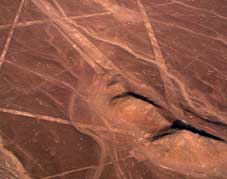
The
reason we were in Nazca was to visit the famous synonymous lines and
geoglyphs that cover a large track of desert south of town. These spectacular
geometric designs drawn in the desert are visible only from the air. Some represent
animals, such as a 180m-long lizard, a 90m-high monkey with an extravagantly
curled tail and a condor with a 130m wingspan. Others are simple but perfect
geometric figures. They were made by removing sun-darkened stones from the desert
surface
to expose the lighter coloured stones below. Maria Reiche, a German mathematician
who spent her life studying the lines, thought they were made by the Paracas
and Nazca people from 900 BC to AD 600, with 7th century additions by Wari settlers
from the highlands. There are other theories, the more popular one today being
that they were linked to rituals in the lost city of Cahuachi, which is still
being uncovered slowly. Some other people think that it could also have been
done by aliens.
Anyway,
we thought that the answer was up there somewhere so we took a flight to check
it out for ourselves. It was a very small plane, 4 people maximum including
the pilot. I sat next to him just in case he needed my help while Catherine
and Simon sat behind us. The flight lasted just 30 minutes but if was more that
enough for the three of us. The pilot would make some quick turns while descending
perilously bringing our lunch dangerously to our lips. As I quickly looked over
my shoulder I
noticed
my two soul mates with their head in plastic bags, not giving a shit about the
scenery. We survived but did not discover anything new about the mystery lines.
Saturday, 17 January.
I was heading to Cusco, not to visit Machu Picchu but to visit a World Vision
project. Simon, who had heard that it was very cold and raining that way,
decided to keep going along the coast to Chile and to avoid Bolivia altogether.
Weak, delicate, fragile and frail is our Simon, don't you think? Catherine,
in the comfort of her car, was going to Machu Picchu as well. I took advantage
of her half empty vehicle to put all my luggage in it. We knew that it was
going to be a long journey (670km) so we left at 7am. Right away, the road
started to climb steadily with superb views on both side. We eventually reached
4345m, a record altitude for this trip so far (I rode over 5000m in Pakistan
in 97). It was very cool, around 8 degrees according to Catherine's thermometer.
We rode on that magnific road for around 100km, there was no traffic whatsoever.
We could see hundreds
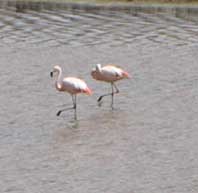
of wild llamas as well as Pink Flamingos (photo). At that altitude no trees
or vegetations can grow. Far in the distance, we could see higher mountains
covered with snow. Then the road started to descend slowly for many km, the
temperature raised once more and the vegetation reappeared. We followed a river
in the bed of a valley all the way to the village of Chalhuanca where
we stopped for lunch. The road, then, followed the valley for another 100km
before starting to climb again. As we got close to the summit of the pass (3900m),
the rain and the fog appeared, making the going tough for me. We
eventually arrived in Cusco at night fall after
a long (12 hours) but most stunning ride. I would recommend this road to anyone
as it was one of the most enjoyable ride of my trip so far.
Cusco
was the capital of the Inca Empire, and most of its central streets are
lined with Inca-built stone walls, which now form the foundations of colonial
or modern buildings. The streets are often stepped and narrow and crowded with
Quechua-speaking descendants of the Incas. Because of its central location in
the Andes, and its proximity to Machu Picchu and the Inca trail, the archaeological
capital of the Americas draws tourists from all over the world.
I will tell you a couple of things about the Inca but, don't
worry,
I will make it short. The period of cultural and imperial pre-eminence by the
Inca is in fact a fairly short one in historical term, around 100 years from
1438 to 1532. The conquistador Francisco Pizarro, from Spain, defeated
Atahualpa, the leader of the Inca, and marched into Cusco as the new
conquering overlord (bastard). The Inca Empire was dead.
The
actual purpose and function of the citadel of Machu Picchu (Photo courtersy
of Catherine) is still a matter of speculation and educated guesswork. Perhaps
it was founded in the waning years of the last Incas as an attempt to preserve
Inca culture. It may have been a religious site established in a vain effort
to rekindle Inca predominance when under threat by the invading Spaniards. Or
it may have existed all along at the peak of Inca glory. Nobody really knows.
The Incas never had a written language, thus virtually all details of Inca history
come to us from these Spanish
records.
Are you still with me? Good. Apart from a few indigenous Quechuas, nobody
knew of Machu Picchu's existence until American historian Hiram Bingham
stumbled upon it in 1911. The ruins that Bingham discovered were thickly over-grown
with vegetation, so his team had to be content with roughly mapping the site.
Bingham returned in 1912 and 1915 to clear the thick forest. Further studies
and clearings were carried out by Peruvian archaeologist in 1934. Today, Machu
Picchu is one of the most visited places in all South America. As I mentioned
it before, I visited it about 14 years ago. I also walked the Inca trail; some
people call it the "Inca trial" because it is quite tough. It is only
33 km long but it is very strenuous as you have to climb at over 4000m a couple
of time. It took me four days. The views of snow-capped mountains and high cloud
forest were stupendous. Walking from one ruin to the next was a mystical, unforgettable
experience. Today, you can hire porters, guides and cooks but it is quite expensive.
If you want just to go there for one day by train, it will cost you around US$100,
definitely too much for my budget on this trip. That is why I will not visit
Machu Picchu this time. I have also read somewhere that the Peruvian government
put 49 million dollars in his pocket each year from the tourists visiting
Machu Picchu. What pisses me off the most it's that nothing goes to the local
population who lives in deplorable condition. This explain the presence of World
Vision in the area.
They have been operating in Peru for 25 years. They have a few projects around
Cusco which are funded by Australia once again. On the day of my visit they
took me to visit a young boy who had suffer from a cleft lip and a cleft palate
(WV Peru have asked me not to mention his name and not to put a photo of him
on my web site, don't ask me why). Obviously, he was born like that. He had
a hole in the palate of his mouth which connected directly to his nose. He could
not eat, drink or talk. WV paid for his 4 operations and now, at the age of
6, his is a normal boy. He will start school next year but already he can talk
like a boy of his age. Without the help of WV his mum could never have been
able to afford the operations and he probably would have died. His mum, who
has 3 other children, lives alone (no husband) and makes a living on buying
Vegetables and Fruits from the farmers living around her village and sells them
again at the market for a small profit.
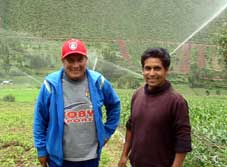
Also
that day, we went to visit a community of 130 families who lives very high in
the mountain. Again they were struggling to survive with their cultivation.
In this region, it only rain for 3 months a year but now WV have introduce a
system of water irrigation which give them the chance to have two harvest per
year. They are now able to sell whatever is left over. The cost of the system
was US$60,000 which was taken care by WV Australia. Saturnino Calderon
(right on
the
picture) is the leader of the community and he told me that even though the
system has been installed only a year ago, he can see a big change for the community
and he is looking forward to a better life for his family. They are also able
now to grow fruit trees like peach, pear and apple.
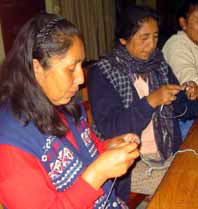
Then
we went to visit an Economic Development in Cusco. The focus of this program
is centred on Women. The idea is to give them more self-esteem and polish up
their skills and abilities and their role in the family. The most popular courses
and workshops are making shoes and purses out of macramé, sewing, crochet,
stuffed animals, and cold ceramics, weaving cloth, embroidering and silk screening,
decorative art and cosmetology. The process of developing skills is backed up
by training in managing micro-enterprises or in improving small businesses by
using resources to the best advantage. One woman said to me "We have improved
our economy a lot… this year. During the rainy season there was no work
for my husband who is a bricklayer. I matriculated my daughter in secondary
school and bought her school supplies. For three months I supported the family
selling the purses I made". It was great to see that now; the women have
a chance to do something for the family and for themselves. They were so excited
to show me how they could knit jumpers and make bags and shoes.
The next day, Jose Abel Condori took me to visit some holiday schools.
In Peru, the children have nearly 3 months
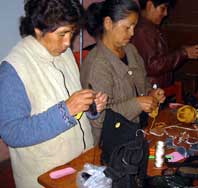
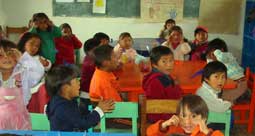
break
from school, December to March. WV has created centres where children, from
the age of 4 to 15, can attend during the day. I had a lot of fun with them,
mostly answering their questions. They wanted to know many things about Australia,
like what kind of animals do we have or what do we eat for breakfast. One teacher,
a lady, surprised me when she asked me how many kms could I do
with my rear tyre. I was ready for any questions
but this one. If it was not for those centres, the children would be in the
streets but instead they learn more things and they told me that "they
love it because it is more fun that the real school".
Thank you to the staff of WV in Cusco for showing me all those projects and
no thanks to the Peruvian government for keeping all that money for themselves.
On my last day in Cusco I went to visit some
villages
around
Cusco, villages away from the tourists. Markets are a favourite of mine, I love
watching
the
locals selling or buying their food. In South America, those markets are very
colourful and very different from one another. I also went for a walk in a very
tiny hamlet. The people seemed so happy to have a tourist in their village.
I talk to them and had fun filming them then showing it back to them (pictured).
To see and to hear themselves on the video was completely incomprehensible to
them, especially with the oldest people. Usually, they are a little timid at
first but as soon as you start to speak with them they become so friendly.
It
is moments like that that makes my travelling so enjoyable and pleasant.
Friday, 23 January.
My next stop was Puno(400km away) on the shore of Lake Titicaca.
I was worried about the rain but as it turned up I only had a couple of light
showers. For the first 150 km, the road followed a very fertile valley with
plenty of farmers working in the fields. Then the road climbed to 4200m. It
was very cold and all the surrounding mountains were covered with snow. The
only animals around were llamas. Talking about llamas, I have a question for
you and whoever will email me with the best answer will receive a postcard from
my next destination. Here is the question. "Who can tell me why llamas
cannot really survive below 3300m?" Go on, have a go and send your email
to didierm@comcen.com.au Your answer
and your name will be publish in my next update.
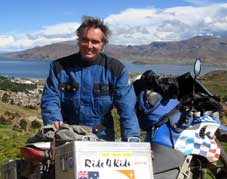
I
arrived in Puno at 3pm and I was welcome by a spectacular view of Lake Titicaca.
The sky was blue and because at this altitude the air is unusually clear, the
deep blue of the lake is especially stunning. More than 230km long, 97km wide
and at an elevation of 3820m, Lake Titicaca is among the world's highest navigable
lakes. Straddling the Peru-Bolivia border (60% in Peru and 40% in Bolivia),
it covers an area of about 8549 sq km. It's a remnant of the ancient inland
sea know as Lago Ballivian, which covered much of the Altiplano before
geological
faults and evaporation caused the water level to drop. The lake is a brilliant
splash of clear, blue waters amid the sere no-man's land of the Altiplano.
The
next day I went to visit some of the islands. The ones that interested me the
most was the floating Islands which are made entirely of buoyant reeds
(pictured). Those Islands are made and are inhabited by the Uros people.
The Uros have intermarried with Aymara-speaking indigenous Peruvians, and no
pure-blooded Uros remains. Always a small tribe, they began their unusual floating
existence to isolate themselves from the Collas and the Incas. Their lives are
totally interwoven with the totora reed, which grows abundantly in the shallows
of the lake. They harvest these reeds and use them to make
everything,
from the islands to themselves to their boats. The islands are constructed from
many layers of reeds, which rot away from the bottom and are replaced at the
top. They usually last around 12 to 15 years. Their little boats can carry the
whole family and, if there are well made, can last 6 months. They have their
own floating schools and health centres.
Next I took a boat ride to Isla Taquile (Taquile Island) that lasted
two and half hours. Even though the day started with a little rain, it eventually
turned out to be a perfect day with a beautiful
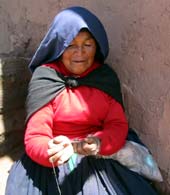
blue
sky. Taquile is a fascinating island. The people wear colourful traditional
clothes, which they make themselves and sell in the island's cooperative store.
They speak mainly Quechua and have maintained a strong group identity. I was
surprised to see that the island has no roads, no cars and almost no dogs. I
walked along some paths where I was able to see several hills with pre-Inca
terracing and small ruins. I had a most pleasant and relaxing day exploring
the ruins and enjoying the peaceful scenery. Tomorrow I will ride to the Bolivian
border which is only 150km from Puno.
I hope that you have enjoyed this update and I will return soon with more stories
on Bolivia.
JOURNAL 32.
25/01/04 . Pérou . Kilométrage
total 61,085km .
Pour revenir à la version française
du site, cliquez sur Français
Machu Picchu
et l'Empire des Incas.
Vendredi 9 Janvier 2004.
Le passage de la frontière se passa comme sur des roulettes. Encore
une fois, j'utilisais mon carnet de passage en douane (bien qu'il soit périmer)
pour entrer ma moto au Pérou. Pour des raisons que j'ignore, je n'avais
pas pu me servir de mon carnet de passage (passeport pour la moto) en Amérique
Centrale mais il semble que se soit différent en Amérique du
Sud.
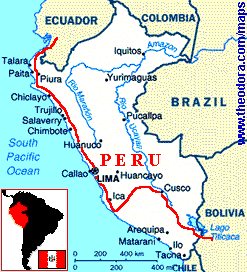
C'est
ma deuxième visite au Pérou; la première était en
1990. Le Pérou est le troisième plus grand pays d'Amérique
du Sud après le Brésil et l'Argentine. Sa population est de 27
millions d'habitants. C'est ici que l'on trouve le plus beau site archéologique
du continent - Machu Picchu. C'est aussi au Pérou que le fameux
empire des Incas est née, il y a de ça plus de 600 ans. Géographiquement,
le Pérou a trois régions différentes, l'étroite
ceinture le long de la côte qui est principalement désertique,
la cordillère des Andes et la région amazonienne. C'est principaux
exports sont le cuivre, des produits agricoles, de l'or et de l'essence. Mais,
apparemment, la production de la feuille de coca (exportée pour la production
de cocaïne) rapporterait plus que tous les autres produits réunis.
Aujourd'hui, le
touriste
joue aussi un rôle important dans l'économie de la nation (surtout
pour le gouvernement). Pour ceux qui se demandent où l'Amazone
prend sa source, eh bien je vais vous le dire. L'Amazone prend sa source dans
le Nevado Mismi, une montagne au sud du Pérou.
Peu après midi, nous étions au Pérou sur une superbe route
qui longeait la côte. Catherine était toujours avec moi
et nous poursuivions notre camarade anglais Simon au guidon de sa Honda Transalp.
Le temps était irréprochable et le paysage complément différent
de ce que j'avais vu depuis un mois. A ma droite, l'océan Pacifique étincelait
sous les rayons du soleil et sur ma gauche, le désert s'étendait
à perte de vue. Nous nous arrêtions sur le bord de mer pour un
festin de poisson dans un petit restaurant. Nous arrivions à Puira (ayant
parcouru 540 Km) vers 16 heures tout heureux d'être en vie. Puira
est la plus vieille ville coloniale du Pérou et compte environ 300 milles
habitants. Les nombreuses rivières, qui coulent sur le flanc ouest de
la cordillère des Andes, forment une quarantaine d'oasis le long de la
côte. Ces oasis sont des centres agriculturals important dans cette région
désertique. Toute la région autour de Puira est un de ces centres.
C'est là que nous retrouvions Simon. Il avait l'air d'être content
de nous revoir car, il avait du attendre 3 semaines au Panama pour un visa pour
la Colombie puis il avait passé un Noël et un jour de l'an en solitaire
en Colombie et pour ajouter du gaz au feu (ou du gaz au feu, je ne sais plus),
il était resté bloquer 5 jours à la frontière Colombienne/Equateur
parce que les douaniers en avaient décidé de prendre un congé
sympathique.

Le
lendemain, je reprenais la route de bonne heure avec mes deux compagnons, direction
Trujillo. La route et le temps n'avaient pas changé de condition ce qui
nous rendait aux anges. Le désert me r'appelait le désert du Nullarbor
en Australie et c'était un plaisir rafraîchissant de traverser
les oasis de temps en temps. Nous atteignons notre destination en fin d'après
midi ayant parcouru seulement 442 Km. Un déjeuner de deux heures (très
exceptionnel pour moi) n'avait rien arrangé. Trujillo est la
troisième
ville du Pérou et la plus grande dans la partie nord du pays. C'est une
jolie ville qui a retenu toute sa splendeur coloniale. Nous passions une agréable
soirée à explorer la ville et à observer les gens faire
leurs courses du Samedi soir. C'était difficile de se croire au Pérou
car les magasins modernes et les passants bien habillés n'avaient rien
en commun de ce que je me r'appelais de ce pays.
Nous n'étions plus qu'à 600 Km de Lima (la capitale), une
distance facile à franchir pour le lendemain. Nous avions un peu de mal
à sortir Simon de son lit mais nous y parvenions en faisant beaucoup
de bruit autour de lui. C'est donc vers 9 heures que nous quittions notre logis
bien décidé à parvenir à la capitale. Le désert
rocailleux avait fait place à un désert sableux qui me ramenait
au Soudan ou en Egypte. L'océan avait disparu depuis longtemps et les
dunes de sable l'avaient remplacé. Simon, qui n'avait jamais roulé
en moto dans le sable (un puceau en quelques sortes), insista pour aller voir
les dunes de plus prés. Avec les dernières étapes du Paris
Dakar encore toutes fraîches dans sa mémoire, il quitta notre belle
route goudronnée pour s'envoler vers les dunes de sable comme s'il était
en tête de ce raid. Je le suivais doucement derrière connaissant
très bien les pièges du sable. Les journées entières
passaient à déterrer ma moto dans le nord du

Soudan
m'avait appris un truc ou deux. . Trois minutes plus tard, je remarquais que
Simon avait ralenti, en fait il n'avançait plus. Il avait déjà
enterré sa roue arrière à plus de 50cm dans le sable moue
(photo). "Comment dois-je faire pour la sortir" me demanda
Simon. Comme j'étais presque sure qu'il parlait de sa moto, j'accourais
à son secours. Il nous fallu retirer tout ses bagages pour sortir sa
moto du trou qu'il avait creusé sous le sourire, qui voulait en dire
long, de Catherine. Dix minutes plus tard nous
retrouvions
toute la sécurité de la route bitumée. Simon, encore tout
penaud, jurait que sa carrière de pilote d'enduro était finie.
Le plus les kilomètres de Lima diminuait le plus le nombres de flics
au bord des routes augmentait. Roulant en tête, j'étais le premier
à dérouiller. Je me faisais arrêter juste à quelques
mètres d'un péage (gratuit pour les motos). Le flic, un gaillard
aux allures de bête féroce, m'accusait d'avoir rouler sur la ligne
jaune alors que j'approchais du péage. S'en attendre, il prenait mon
permis de conduire et commençait à remplir le procès verbal
tranquillement. Le verdict, 50 Euros et mes yeux pour pleurer. En plus, comme
c'était Dimanche, il me fallait attendre le lendemain pour payer la note
et retrouver mon permis (un peu comme au Nicaragua). Il remplissait le procès
tellement doucement qu'il était clair qu'il attendait de se faire graisser
la patte, une formule dont j'ai horreur mais qui est très populaire en
Amérique du sud. Donc je faisais l'ignorant et je crois qu'avec un peu
plus de temps je serai parvenu à l'épuiser avec ma patience légendaire
mais Simon et Catherine m'attendaient et en plus il commençait à
ce faire tard. Alors, pour la première fois de ma vie, je devais m'abaisser
et payer un bakchich à un flic. Je lui offrais 6 Euros qu'il acceptait
en soupirant. Je m'en sortais fort bien car plus tard on me disait que les flics
n'acceptent pas moins que 15 à 25 Euros pour vous laisser reprendre la
route.
Il nous restait encore 150 Km à faire et nous voulions à tout
prix les faire avant la nuit. Pas plus de 40 Km plus loin, les flics arrêtaient
Simon et moi-même. Cette fois ils nous reprochaient d'avoir fait du 64
Km/h dans une zone de 45. Bien que nous étions coupable, nous prétendions
de ne rien comprendre. Catherine faisait demi-tour pour voir si elle pourrait
plaider non coupable en notre faveur (c'est une avocate de première classe).
En retour, elle se faisait verbaliser pour avoir fait un demi-tour dans un endroit
non autorisé. En tout autres circonstances, j'aurai éclaté
de rire tant la situation était comique. Simon n'osait même pas
se gratter l'oignon de peur de recevoir un autre PV. Les flics, sérieux
comme deux curés après une bénédiction, remplissaient
les formulaires en prenant des airs important et en nous répétant
que nous avions vraiment commis des offenses impardonnables. Je ne sais pas
si se fut nos airs de bêtes battus ou le sourire de Catherine qui voulait
dire 'je peu faire n'importe quoi pour vous' qui nous sauva mais ils nous laissaient
éventuellement partir sans rien nous faire payer. Tout surpris, nous
leur promettions d'être très vigilant et de ne jamais recommencer
nos bêtises. Nous parcourions les 100 derniers Kms au pas sous l'œil
très intéressait des forces de l'ordre qui étaient placées
tous les 5 Km et armées de leurs radars. Nous arrivions finalement dans
les faubourgs de Lima, alors que la nuit tombait.

Le
charme colonial de Lima a été submergé par une incontrôlable
explosion de population qui commença dans les années 1920. A peu
prés un tiers de la population du Pérou vit à Lima ce qui
rend cette ville surpeuplée, polluée, dangereuse et bruyante.
La grande majorité de l'augmentation de la population vient des coins
les plus dépourvus du Pérou. En effet, les pauvres gens ne peuvent
pas survivre dans ces endroits et ils viennent tenter leurs chances dans la
capitale. Mais il n'y a pas de travail pour eux et ils finissent dans des bidonvilles
autour de la ville. Ces cantonnements sont dépourvus d'électricité,
d'eau et de toute hygiène. Lima souffre aussi du brouillard de la côte
qui
bloque
le soleil et enveloppe les buildings dans un drap gris mais cela se dégage
souvent dans l'aprés midi. La pollution rend les promenades difficiles
dans les rues.
En 1990, lors de mon premier voyage en Amérique du sud, j'étais
venu directement à Lima de Los Angeles (en avion). On m'avait raconté
beaucoup d'histoires dramatiques, vols à main armés étaient
des choses de tous les jours. Donc je m'attendais au pire, en plus, je ne parlais
pas un mot d'espagnole. Ce premier jour, alors que je me préparais à
tout, je partais dans le centre ville avec juste une photocopie de mon passeport,
quelques pesos pour assouvir ma faim et un sac à dos avec un guide de
route et une bouteille d'eau, comme ça j'étais sure que je ne
me ferai rien voler. O! Combien je me trompais. Alors que je marchais sans demander
rien à personne, un personnage, fort douteux, m'accosta et me demanda
quelque chose que je ne compris pas. Je n'avais pas eu le temps de reprendre
mon chemin qu'un policier nous aborda et nous demanda nos papiers d'identités.
Le type n'en avait pas et moi, je lui présentais ma photocopie. Bien
sur, cela ne suffisait pas et il nous embarquait dans un fourgon direction le
commissariat pour une vérification plus soutenue. Vous pouvez comprendre
que je ne me sentais pas vraiment brave, après tout je venais à
peine d'arriver et j'étais déjà arrêté. Les
choses allaient empiraient dramatiquement. Sur le chemin du commissariat, un
des agents commença à inspecter les bras du type douteux. On pouvait
y voir des traces d'injections. Il inspecta les miens aussi sans rien y trouvait
d'anormal. Puis il regarda dans mon nez avant de me retirer ma ceinture, celle-ci
subit une inspection très ordonnée. Mon sac à dos, à
son tour, fut perquisitionné. Il en sortit, à mon grand étonnement,
un petit sachet rempli de poudre blanche. Le flic me le montrait avec un sourire
moqueur, je compris tout de suite son piége. Ces enfoirés m'avaient
tendu un guet à pans. J'entrais dans le commissariat plus blanc que le
sachet et je me retrouvais accuser de trafic de drogues. Ils me firent comprendre
que je risquais de 4 à 5 ans de prison ferme. Quel cauchemar! Je venais
à peine d'arriver au Pérou, je ne connaissais personne et je ne
savais même pas si il y avait une ambassade Australienne pour me tirer
d'affaire (j'appris plus tard qu'il n'y en avait pas). De dire que je commençais
à me faire du soucis n'aurait pas effleuré les sentiments que
je ressentais à cet instant. Ils me jetèrent dans une petite cellule,
histoire de me faire mouronner, pendant 2 heures. Ensuite ils me ramenèrent
et me firent comprendre que si je payais US$1000 je serai libéré.
Je n'en croyais mes oreilles, c'était un coup monté et j'en étais
la victime. Cette somme d'argent était tout ce que j'avais pour mon séjour
en Amérique du sud et je n'allais pas m'en débarrasser aussi facilement,
donc je refusais. On négociait toute l'après midi. Ils me renvoyaient
dans la petite pièce de temps en temps pour me faire réfléchir.
Finalement, j'acceptais de payer US$200. Ils m'accompagnaient à mon hôtel,
puis dans une banque où je pouvais changer assez de chèques de
voyage pour pouvoir les payer. Que me restait il à faire? Aller chez
les flics et déposer une plainte? Je n'y croyais guère donc je
la fermais et quitter Lima le lendemain. Aujourd'hui, il y a une police juste
pour les touristes, afin d'éviter de tels problèmes.
Lundi 12 Janvier 2004.
Je profitais d'être à Lima pour visiter le bureau national de
World Vision et ces derniers m'offraient de visiter un projet à
Cusco, non loin de Machu Picchu. J'avais prévu de passer par
Cusco car c'était sur la route vers la Bolivie. C'était parfait
et nous nous donnions rendez-vous pour la semaine suivante. Je changeais l'huile
de ma moto ainsi que les plaquettes de frein arrière. J'étais
un peu surpris de les voir si user car elles n'avaient que 15,000 Km, les
précédents avaient duré 44,000 Km.
Trois plus tard, je quittais Lima en compagnie de mon fidèle compagnon
Simon, en direction de Nazca, un petit village à 470 Km au sud
de Lima. Une route excellente et un temps idéal rendaient la promenade
très plaisante. Je n'avais aucun problème à garder Simon
loin des dunes de sable. La

raison
de notre visite à Nazca était d'étudiée les fameuses
lignes et géoglyphes qui recouvrent une grande partie du désert
au nord de cette ville. Ces spectaculaires géométriques formes
dessinées sont visible que par avion. Certaines représentent des
animaux, comme par exemple un lézard long de 180m, un singe de 90m avec
une queue extravagante et un condor avec des ailes de 130m. D'autres sont plus
simples mais toujours avec des formes très géométriques.
Maria Reiche, une mathématicienne Allemande, qui passa sa vie
à étudier ces formes, pensa que
ces
lignes avaient été dessiné par les Paradas ou les gens
vivant dans la région entre 900 BC et 600 AD. Il y a eu d'autres théories
mais rien n'est certain. Certains pensent même que se serait les Martiens
qui seraient passés par là. Comme le seul moyen d'étudier
ces formes était par avion,
Simon,
Catherine et moi-même sautions dans un petit 4 places. Je prenais place
à coté du pilote en cas qu'il est besoin de mes connaissances
spatiales tandis que mes compagnons de fortune prenaient place derrière
nous. Le vol dura juste 30 minutes mais ce fut plus que suffisant pour nous
trois. Le pilote, qui voulait sans doute m'épater, faisait des demi-tours
soudain suivis par des descentes périlleuses qui faisaient remonter notre
dîner de la veille dangereusement au bord de nos lèvres. Alors
que je jetais un coup d'œil rapide derrière moi, je remarquais que
mes deux collègues avaient
enfui
leurs visages dans des sacs en plastique en s'attendant au pire et en évitant
tout regards par la fenêtre. Nous survivions quand même sans découvrir
rien de plus sur les mystérieuses formes.
Samedi 17 Janvier.
J'allais vers Cusco, pas pour voir Machu Picchu mais pour visiter un projet
de World Vision. Simon, qui avait entendu dire que la pluie et le froid nous
attendaient de ce côté du pays, décida de continuer le long
de la côte vers le Chili et de rester le plus loin possible de la Bolivie.
Serait-il délicat et fragile notre petit Simon? Catherine, dans le confort
de sa voiture, n'hésita pas à faire route avec moi. Pour équilibrer
les choses, je m'étais une grande partie de mes bagages dans sa voiture.
Merci Catherine. Nous savions que la route allait être longue, 670 Km,
et dure pour certain. Nous prenions la route vers 7 heures du matin et aussitôt,
celle-ci se mit à grimper progressivement avec des vues superbes sur
le désert que nous laissions derrière nous. Nous avons éventuellement
atteint une altitude de 4345m, un record de hauteur pour ce voyage (j'ai roulé
à plus de 5000m au Pakistan en 97). Il faisait très froid, environ
5 degrés d'après le thermomètre de la voiture de Catherine.
Nous roulâmes sur cette route magnifique pendant 100 Km, il n'y avait
pas la moindre circulation. Nous

pouvions voir des centaines de Lamas sauvages
ainsi que des Flamants roses aux bords des points d'eaux. A cette hauteur,
aucune végétation ne pousse. Au loin, des montagnes enneigées
nous observaient de leurs grandeurs. Cet endroit s'appelle l'altiplano, un endroit
dépourvu, en bonne partie, de vie humaine. Finalement, la route a commencée
à descendre lentement mais sûrement pendant des Kms en suivant
une rivière qui creusait une vallée le long de son passage. La
végétation et la chaleur avaient réapparu ainsi que les
Indiens. A 1300m, nous faisions halte à Chalhuanca pour déjeuner.
Ensuite, la route a continué le long de cette vallée fertile pendant
encore 100 Km avant de
recommencer
à grimper rapidement vers un autre sommet à plus de 3900m. Il
avait commencé à pleuvoir peu avant la cime et le brouillard nous
ralentissait. Nous arrivions à Cusco à la tombée de la
nuit après une dure journée de 12 heures sur la moto. Je n'hésite
pas à qualifier cette route d'une des meilleurs de mon voyage, vraiment
un souvenir inoubliable.
Cusco
était la capitale de l'empire des Incas, et beaucoup de ses rues centrales
sont longées de murs construits par les Incas, qui maintenant forment
les fondations de coloniales et de modernes bâtisses. Les rues montent
souvent à pics, elles sont aussi étroites et pleines de descendants
Inca qui parlent maintenant le Quechua. Pour sa location centrale dans les Andes
et sa proximité de Machu Picchu et du sentier des Incas, cette capitale
archéologique attire des touristes du monde entier. Le pourquoi et la
fonction de la citadelle de Machu Picchu n'est toujours pas connue (Photo
ci-dessous prise par Catherine). Certains disent
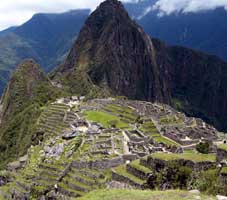
qu'elle
a été construit juste à la fin du règne des Incas
pour préserver leurs histoires. D'autres disent que ce serait un site
religieux établi en vain pour faire revivre la prédominance Inca
alors qu'ils étaient menacés par les Espagnoles. Mais il est aussi
possible qu'elle a toujours existé, en pleine gloire de l'empire Inca.
Les Incas n'écrivaient pas, alors 'bonjour' pour les infos. Aujourd'hui,
Machu Picchu est le site le plus visité d'Amérique du sud. Je
l'ai visité en 90 en parcourant aussi le sentier des Incas. Le sentier
des Incas n'est pas une randonnée facile. Cela prend 3 à 4
jours et pourtant il ne fait qu'environ 33 Km. Il monte aux alentours de 4000m
donc pas
évident
si vous êtes un fumeur. Maintenant, le sentier des Incas est devenu un
commerce, Il faut compter 150 Euros pour pouvoir le faire. Un guide est obligatoire,
plus la bouffe, les porteurs, l'entrée du parc de Machu Picchu et bien
sur le train pour revenir à Cusco. En 90, je l'avais fait avec deux Danois
et cela nous avait coûté environ 10 Euros tout compris. Je dois
quand même admettre que la vue des montagnes enneigées environnantes
et des forêts nuageuses était incroyable. De même que de
marcher d'anciennes ruines à anciennes ruines fut une expérience
inoubliable. Toujours est-il qu'il n'était pas question que j'y retourne,
en plus j'ai appris que Machu Picchu rapporte 49 millions d'Euros par an au
gouvernement Pérouvien et que cela ne rapporte absolument rien aux gens
de la région. Ceux-ci vivent dans la pauvreté la plus complète
pendant que les touristes les fusillent avec leurs appareils photos.
La raison de ma visite dans la région, comme je l'ai dit antérieurement,
était pour visiter un projet de World Vision, très présent
dans la région. Ils y sont depuis 25 ans. La majorité des developpement
sont finances par l'Australie, les Etats-Unis et le Canada. Le jour de ma visite
ils m'emmenèrent voir un jeune garçon avait souffert d'une fissure
de la lèvre et d'une fissure du palet (bec de lièvre, je crois
en français). Clairement, il est né comme ça. WV Pérou
ne m'a pas permis de mettre une photo de lui sur mon site pour des raisons de
discrétion et de vie privée. Ce garçon, qui a maintant
six ans, avait un trou dans le palet qui allait directement dans son nez donc
il ne pouvait n'y boire n'y manger. Il en serait mort sans l'intervention de
WV qui prit en charge toutes les opérations chirurgicales. Sa maman,
une mère de 4 enfants et vivant sans mari, gagne de quoi nourrir ses
enfants en vendant des fruits et légumes qu'elle achète dans les
fermes voisines et qu'elle revend sur le marché. Elle n'aurait jamais
pu payer la facture d'une telle intervention.
Ensuite, nous avons visité une communauté de 130 familles qui
vivent très haut dans la montagne. Encore une fois, ils avaient de grandes
difficultés à survire de leurs cultures. Dans cette région,
il ne

pleut
que 3 mois par ans mais maintenant WV a introduit un système d'irrigation
leur permettant d'avoir deux récoltes par an mais aussi de faire pousser
d'autres produits. Ils peuvent maintenant vendre le surplus et envoyer les enfants
à l école. Le système d'irrigation à coûter
60 milles Euros et c'est WV Australie qui a tout pris en charge. Saturnin Calderon
(a droite sur la photo) est le chef de la communauté et il m'a dit qu'il
voyait déjà un grand changement dans les familles. Il m'a aussi
dit qu'ils vont planter des pêchés, des poiriers et des pommiers.

Nous
avons aussi visité un développement économique à
Cusco. Ce programme est tourné particulièrement pour les femmes.
L'idée est de leur donné le courage de sortir de chez-elles et
de leur apprendre d'autres activités. Les cours les plus populaires sont
le tricotage, le crochet et la fabrication de chaussures et petits sacs. Le
développement inclus aussi la comptabilité et le savoir de contrôler
une micro entreprise. Une femme m'a dit "Nous avons beaucoup augmenté
nos finances…cette année. Pendant la saison des pluies, il n'y avait
pas de travail pour mon marri qui travaille comme main d'œuvre. J'ai pu
inscrire ma petite fille à l'école secondaire et acheter tout
ce dont elle aura besoin grâce à la vente de ce que je fabrique.
J'ai
pu soutenir ma famille moi-même pendant 3 mois". C'était super
de voir que les femmes ont maintenant la chance de faire quelques choses pour
eux même et pour leurs familles.
Le
lendemain, José Abel Condori m'emmena voir des centres écoliers
pour enfants en vacance. Je vous explique. Au Pérou, les enfants on Presque
3 mois de vacance, de Décembre à Mars. WV a crée ces centres
pour permettre aux enfants de 4 à 15 ans à venir suivre des activités.
J'étais fort surpris par le nombre d'enfants présent et quand
je leur demandais s'ils ne préféreraient pas jouer dehors avec
leurs camarades, ils me répondirent non car ces classes étaient
différentes de l'école ordinaire et au moins, là, ils avaient
la chance d'apprendre d'autres choses. Je passais une superbe journée
à répondre à
leurs
questions. Ils voulaient tout savoir de l'Australie, les animaux, la grandeur
de ce pays, ce que les gens mangeaient le matin… Une institutrice m'a surpris
quand elle me demanda combien je pouvais faire de Km avec un pneu arrière,
je m'attendais à tout sauf à ce genre de question.
Merci beaucoup à tout le personnel de WV Cusco pour m'avoir fait connaître
tant de chose et pas de merci pour le gouvernement corrompu du Pérou
qui ne fait rien pour ces citoyens.
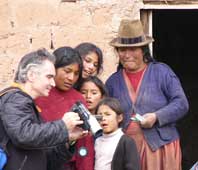
Le
jour avant de quitter Cusco je suis allé visiter des petits villages
loin des touristes. J'adore les marchés, j'adore observer les gens achetaient
ou vendre leurs produits. En Amérique du Sud, ces marchés sont
très colorés et très différents des uns des autres.
Je me suis aussi promené dans de très petits hameaux. Les gens
avaient l'air heureux de voir que j'étais venu les voir et bien que timide
au début, ils m'accueillaient toujours avec le sourire une fois que la
glace était brisée. Je leur parlais et m'amusais à les
filmer puis leur faisait voir le film. De ce voir et de s'entendre dans le vidéo
était une chose
complètement incompréhensible
pour eux, spécialement avec les plus anciens. C'est toujours les moments
comme ça qui rendent mes voyages si intéressants et plaisants.
Vendredi 23 Janvier.
Mon arrêt suivant fut Puno, un village sur les bords du lac
Titicaca. La pluie me tracassait mais en fin de compte je n'avais que
quelques averses pour m'embêter. Pour les 150 Km, la route suivit une
vallée fertile avec beaucoup de paysans travaillant leurs terres. Encore
une fois, la route remonta à plus de 4200m. Il faisait froid et les
montagnes semblaient me suggérer de ralentir pour les admirer. Les
seuls animaux dans la région étaient les lamas. Tiens, en parlant
de lamas, j'ai une question pour vous et celui qui m'enverra la meilleure
réponse, recevra une carte postale de ma destination prochaine et son
nom sera publié ici même dans ma prochaine mise à jour.
Voici la question. " Pourquoi les lamas ne peuvent ils pas vraiment survivre
en dessous de 3300m? ´´ Allez y, n'hésitez pas et envoyer
moi un email à didierm@comcen.comcen.au
ou didiermartin56@hotmail.com

J'arrivais
à Puno vers 15 heures et j'étais accueilli par une vue spectaculaire
de lac Titicaca (photo). Le ciel était tout bleu et à raison
de l'altitude, l'air est un curieusement claire ce qui rend les couleurs du
lac particulièrement extraordinaire. Avec plus de 230 Km de long, 97
Km de large et à une élévation de 3820m, le lac Titicaca
est le lac navigable le plus haut du monde. Il est à cheval sur la frontière
Pérou/Bolivie (60% au Pérou et 40% en Bolivie), il couvre une
surface de 8549 Km/carré. Le lendemain, je profitais d'être dans
la région pour visiter quelques îles. Celles qui m'intéressaient
le plus étaient les îles flottantes. Celles-ci
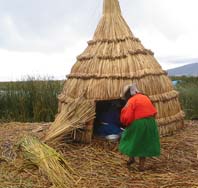
sont
faites d'un genre de roseau (photo). Ces îles sont faites et sont habitées
par les Uros. Toujours une petite tribu, les Uros ont commences leurs
inhabituelles existence flottante pour s'isoler des autres Tribus, en particulier
les Collas et les Incas. Ils ne dépendent que des roseaux qui poussent
à souhait dans la région. Ils récoltent ces roseaux et
s'en servent pour construire leurs îles ou leurs bateaux. Les îles
durent environ 12 à 15 ans et les bateaux seulement 6 mois. Ces derniers,
s'ils sont bien construits, peuvent transporter toute la famille. Ils ont leurs
propres écoles et centres médicaux flottants. Ensuite, je suis
allé visiter l'île de Taquilé. Le voyage en bateau
pris 3 heures
mais
le temps était superbe. L île de Taquilé est impressionnante.
Ces habitants portent leurs habits traditionnels qu'ils font eux même.
Il n y a aucune voiture, route et seulement quelques chiens (quand font ils?)
Je passais une excellente journée à découvrir cette île
que je ne connaissais pas du tout.
Demain je reprends la route vers la Bolivie qui se trouve à environ
150 Km de Puno.
J'espère que vous avez aimé cette page éducative et j'espère
vous retrouver bientôt pour de nouvelles aventures en Bolivie. Je remercie
au passage Catherine de m'avoir donné quelques photos.
A bientôt.
Riding along in northern
Peru.
La route au nord du Pérou.
"Qu'est ce que j'ai
fait?"
"Attends, il faut que
je péte un coup"
"Arrêtes tes conneries!"
"Merci camarade!"
"Il n'y a pas de quoi!"
The "dumb and dumber"
story.
Postcards from Lima (top
photos) and Cusco (below).
Cartes postales de Lima (photos du haut) et de Cusco ( bas).
Woman and child in a village.
Une mère et son enfant dans un village.
Asking the way.
Quelle route suivre?
A baker in front of his oven.
Le boulanger devant son four.
Not a sponsored child.
Un enfant non parrainé.
 |
 |
 |
 |
 |
 |
 |
 |
 |
 |
 |
 |
 |
|
JOURNAL 32.
25/01/04 . Peru . Total mileage
so far 61,085km .
(Pour la version française
du journal, allez au bas de la page ou cliquez
içi.
Pour revenir à la version française du site, cliquez
sur Français)
How
can you help make Ride4Kids a worthwhile project? To find out,
click here.
|
|






